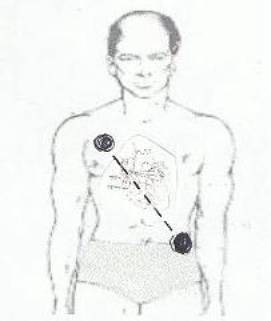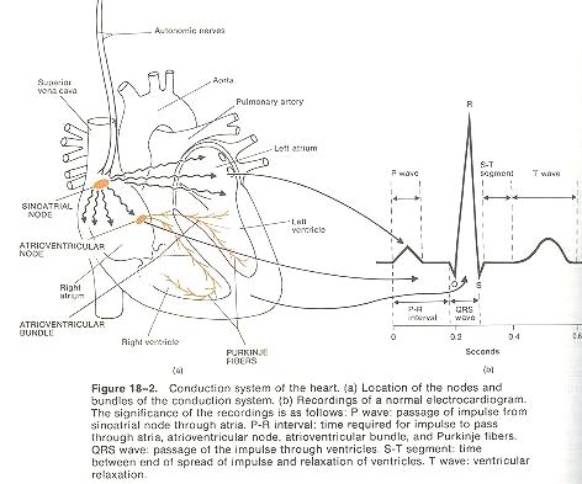The Human Heart: Vulnerable When Hit or Physically Shocked
By Dorothy B. Reitman, Uechi-Ryu Karate
The lay public and newcomers to the martial arts tend to consider the most serious injuries that a person may inflict upon another to be percussive injuries such as the breaking of bones or head injuries. However, strikes that may not even cause bruising could possibly lead to serious injury or even death. [Stephen Drehobl]
The karate style, “Uechi Ryu Karate- Do” contains such a movement that contemporary practitioners still struggle to understand. The strike is called Boshuken Morote Zuki in Japanese, which simply means, “thumb-knuckle strike with both hands”.
The description of the Boshuken Morote Zuki Strike

Modern Arnis Philippine Martial Art “Stick Fighting” Remy Amador Presas
The black circles in the above drawing are the strike zones.
We will refer to the person performing the strike as “A” and the person struck as “B”. “A” drives both hands straightforward in nearly simultaneous bilateral palm heel/thumb knuckle strikes. In kata, the movements are as follows: “A”‘s right hand, starting at the ilium, strikes “B” on the left ilium; “A”‘s left hand, starting at the pectoralis muscle strikes the right pectoralis muscle of “B”. In other words, “A” strikes targets on “B” correspond to his/her own kata starting points. It is important to note that the strike when delivered in a real fight would probably not begin from the origin points in kata. The hands would simply srike from where ever they happened to be at the moment. The kata provides the key to unlocking the mystery of one possible application of this movement by cryptically informing the practitioner where the strike is to be placed on the opponent. The power for this strike is not confined to movement of the arms. It comes initially from the ground /feet, progressing to the knees, hips, waist, and subsequently up the spine and out to the arms to the thumbs. .
Can the shock of the Boshuken Morote Zuki directly affect the heart’s rhythm?

In order to understand the implications of the Boshuken Morote Zuki, we will examine the anatomy and physiology of the heart beat cycle.
The SA node (sinoatrial node) lies in the right atrium beneath the opening of the superior vena cava. See figure 18-2a. Each cardiac cycle is initiated by the SA node and sets the basic pace for the heart rate. The SA node is the pacemaker of the heart. The SA node initiates electrical impulses that spread out over both atria causing them to contract. The impulse then passes to the AV (atrioventricular node) located near the bottom of the interatrial septum. (Between the atrium and ventricle.) Contraction of ventricles is stimulated by the Purkinje fibers. [Principles of Anatomy and Physiology Gerard J. Tortora, Nicholas P. Anagnostakos ]
The operation of the SA node can be disrupted by shock, such as a physical strike to that area of the torso. When something disrupts the SA node the AV node takes over to initiate a basic pace for the heart rate. When both the SA node and the AV node are Almost simultaneously disrupted, the heartbeat can be dangerously affected. The heart could be profoundly affected to the point of cessation of function.
When the right hand strikes the Ilium a shock wave radiates across the torso, while at the opposite “corner” of the torso, the left hand strikes, which also generates a shock wave across the torso in the opposite direction. The proximity to the heart and the SA and AV nodes may allow the shock waves of the strikes to disrupt the operation of the SA, AV nodes and thereby disrupt the timing of the heartbeat cycle. How serious the strike is depends on where in the heart beat cycle the subject is when hit. The intensity of the strike may not have to be very strong in order to have devastating results. An interesting subtlety was noted by Mr. James Thompson, who pointed out that the potential energy in this movement is amplified by the whiplike phenomenon of the hand corresponding to the forward foot always striking almost simultaneously before the hand corresponding to the rear foot. [Oral seminar communication ]
In training, I was struck very lightly with the Boshuken Morote Zuki, and observed that my heart fluttered and that some light headedness occurred. The strike appeared to disrupt the rhythm of my heart. From my perspective as a registered nurse, I believe that the results of this strike could be very serious, even lethal .
Severe disruption of the heart’s life sustaining function is not confined to the martial arts.
In the Philadelphia area alone, several recent newscasts have reported that baseball players struck in the chest by the baseball subsequently lost consciousness and died. A five year old girl in Kyoto, Japan playing catch with friends died after having been struck in the chest by a rubber ball [Mainichi Shimbin, March 17, 2002]
I would like to thank Stephen Drehobl, David Elkins, and Harvey Liebergott for their encouragement and help in preparing this article.
Dorothy Reitman has been studying Uechi Ryu Karate at the Uechi Ryu Karate Academy in Collegeville from Sensei Stephen Drehobl, Yandan since January 2000. She received her Shodan from Sensei James Thompson, Shihan Kyoshi Hachidan June 6, 2003. She has been a registered nurse since July 9, 1977.


